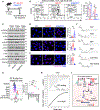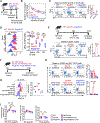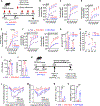The lipid globotriaosylceramide promotes germinal center B cell responses and antiviral immunity
- PMID: 38359115
- PMCID: PMC11404827
- DOI: 10.1126/science.adg0564
The lipid globotriaosylceramide promotes germinal center B cell responses and antiviral immunity
Abstract
Influenza viruses escape immunity owing to rapid antigenic evolution, which requires vaccination strategies that allow for broadly protective antibody responses. We found that the lipid globotriaosylceramide (Gb3) expressed on germinal center (GC) B cells is essential for the production of high-affinity antibodies. Mechanistically, Gb3 bound and disengaged CD19 from its chaperone CD81, permitting CD19 to translocate to the B cell receptor complex to trigger signaling. Moreover, Gb3 regulated major histocompatibility complex class II expression to increase diversity of T follicular helper and GC B cells reactive with subdominant epitopes. In influenza infection, elevating Gb3, either endogenously or exogenously, promoted broadly reactive antibody responses and cross-protection. These data demonstrate that Gb3 determines the affinity and breadth of B cell immunity and has potential as a vaccine adjuvant.
Conflict of interest statement
Figures




References
Publication types
MeSH terms
Substances
Grants and funding
LinkOut - more resources
Full Text Sources
Molecular Biology Databases
Miscellaneous

